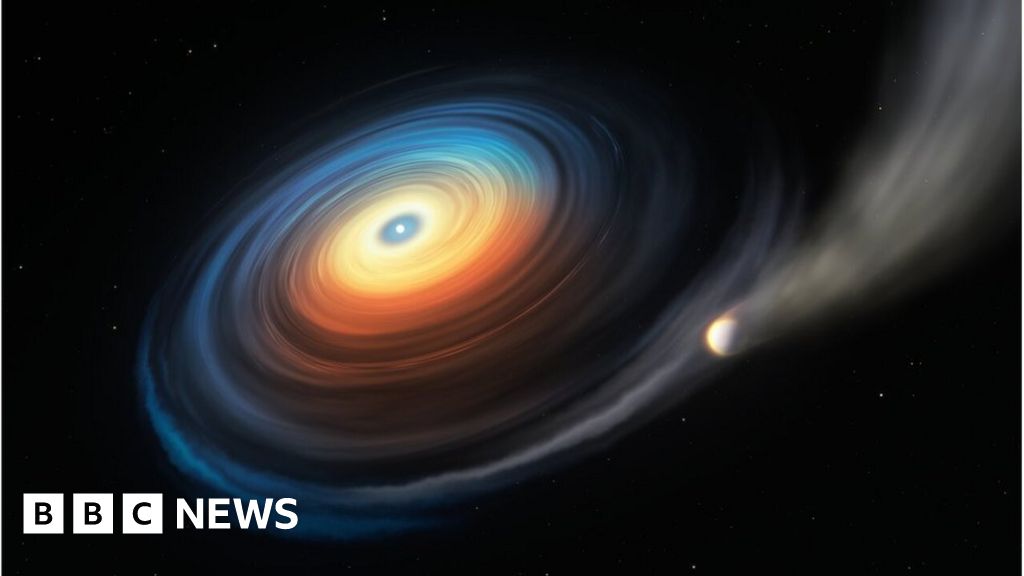
A newly discovered planet offers new insights into the Solar System after the Sun reaches the end of its life in 5-6 billion years.
Astronomers observed a giant planet orbiting a white dwarf, the small, dense objects some stars become once they have exhausted their nuclear fuel.
It's the first direct evidence planets can survive the cataclysmic process that creates a white dwarf.
Details of the discovery appear in the journal Nature.
The Solar System as we know it won't be around forever. In about six billion years, the Sun, a medium-size yellow star, will have puffed up to about two hundred times its current size. In this phase, our parent star will be known as a Red Giant.
As it expands, it will swallow and destroy the Earth before collapsing into a small core called a white dwarf.
Researchers discovered a white dwarf that lies 2,000 light-years away had a giant planet thought to be about the size of Neptune (though it could be larger) in orbit around it.
"The white dwarf we're looking at is about 30,000 Kelvin, or 30,000C. So if we compare the Sun, the Sun is 6,000 - almost five times as hot. This means it's going to be producing a lot more UV radiation than the Sun," said Dr Christopher Manser, from the University of Warwick.
In addition, he said: "The gravitational forces are very large so if a body gets too close to a white dwarf, like an asteroid, the gravity is so strong the asteroid would be ripped apart."
Future-gazing
The giant planet is losing its atmosphere to the stellar relic, leaving a comet-like tail in its wake. The white dwarf is bombarding the world with high-energy photons (particles of light) and pulling the gas towards it at a rate of more than 3,000 tonnes per second.
"We used the Very Large Telescope in Chile, which is an 8m-class telescope... to collect spectroscopy from the white dwarf. Spectroscopy is a method of splitting up light into its component colours," Dr Manser told BBC News.
"By looking at the different colours the system produces, we identified interesting features that told us there was a disc of gas around the white dwarf - which we inferred must be produced by a planet about the size of Neptune or Uranus."
The scientists want to further study the system to shed light on what could happen to our own Solar System when the Sun reaches the end of its life.
"When the Sun reaches its Red Giant phase, it will expand out roughly to the orbit of Earth. Mercury, Venus and, pretty much, Earth will be engulfed by the Sun. But Mars, the asteroid belt, Jupiter and the rest of the planets in the Solar System will expand out on their orbits, as the Sun loses mass because it will have less of a gravitational pull on those planets.
"Eventually, the Sun will become a white dwarf and still have Mars, the asteroid belt and Jupiter orbiting it. As the planets orbit, they can sometimes be scattered and thrown into the white dwarf."
But the radiation emitted by the Sun, once it becomes a white dwarf, will be powerful enough to evaporate the atmospheres of Jupiter, Saturn and Uranus where they are orbiting now. This would leave only their rocky cores.
Follow Paul on Twitter.
"Planet" - Google News
December 05, 2019 at 02:02AM
https://ift.tt/2Yg0Dcu
Planetary system's vision of our Sun's future 'death' - BBC News
"Planet" - Google News
https://ift.tt/2Qdey0Y
Shoes Man Tutorial
Pos News Update
Meme Update
Korean Entertainment News
Japan News Update
Bagikan Berita Ini















0 Response to "Planetary system's vision of our Sun's future 'death' - BBC News"
Post a Comment